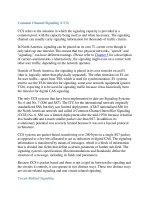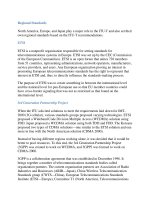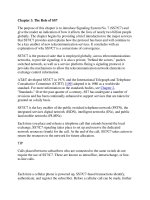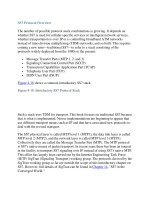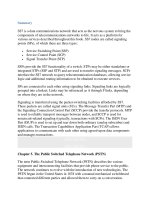Signaling System No.7 Protocol Architecture And Sevices part 8 potx
Bạn đang xem bản rút gọn của tài liệu. Xem và tải ngay bản đầy đủ của tài liệu tại đây (43.88 KB, 5 trang )
Signaling System No. 7: The Key to Convergence
Telecommunications network operators can realize increased investment returns by
marrying existing SS7/C7 and intelligent networking infrastructures with Internet
and other data-centric technologies. SS7/C7 is a key protocol for bridging the
telecom and datacom worlds.
The following sections describe the exemplar hybrid network services that SS7/C7
enable:
• Internet Call Waiting
• Internet Calling Name Services
• Click-to-Dial Applications
• Web-Browser-Based Telecommunication Services
• WLAN "Hotspot" Billing
• Location-Based Games
I
nternet Call Waitin
g
and Internet Callin
g
Name Services
Internet call waiting is a software solution that alerts online Internet users with a
call-waiting message on their computer screens when a telephone call enters the
same phone line they use for their Internet service. The user can then send the call
to voice mail, accept the call, or reject it.
Some providers linking it to CNAM, as mentioned in Calling Name (CNAM),
have enhanced the Internet call-waiting service. This service is known as Internet
calling name service, and it provides the calling party's name and number.
Click-to-Dial Applications
Click-to-dial applications are another SS7-IP growth area. An example of a click-
to-dial application is the ability to click a person's telephone number in an email
signature to place a call. These types of services are particularly beneficial to
subscribers because they do not require them to change their equipment or access
technologies; a POTS and a traditional handset are the only requirements.
Web-Browser-Based of Telecommunication Services
Over the coming decade, we are likely to witness an increase in web based
telecommunications services. An example is customer self-provisioning via the
Internet, a practice that has been in the marketplace for some time and is likely to
increase in both complexity and usage. A customer can already assign himself a
p
remium or toll-free "number for life" via the Internet. The customer can
subsequently use a Web interface to change the destination number it points to at
will, so that during the day it points to the customer's office phone, and in the
evening it points to the customer's cell phone, and so forth.
Another example is the "call me" service, which allows a customer to navigate a
Web page to arrange a callback from a department, rather than navigating
interactive voice response (IVR) systems through the use of voice prompts and a
touch-tone phone.
The potential extends far beyond traditional telecommunications services, to the
p
oint where the distinction between Web and telecommunications services is
blurred. An example of such an enabling technology is Voice Extensible Markup
Language (VoiceXML), which extends Web applications to telephones and shields
application authors from low-level, platform-specific interactive voice response
(IVR) and call control details.
The marriage is not only between SS7/C7, the Internet, and fixed-line networks—it
also extends to cellular networks. Plans are underway to put the location-based
information and signaling found in cellular networks into hybrid use. For example,
Web-based messenger services could access cellular network home location
registers (HLRs) to enable a user to locate a friend or relative in terms of real-time
geographic location.
WLAN "Hotspot" Billing
SS7/C7 has recently begun playing a role in the marriage of wireless (WLANs)
and cellular networks. A subscriber can use a cellular subscriber identity module
(SIM) card for authentication and billing purposes from a WLAN hotspot. For
example, if a subscriber is at a café with WLAN facilities (typically wi-fi), the
subscriber can request permission to use the service via a laptop screen. This
request triggers a short cellular call to authenticate the subscriber (using SS7/C7
signaling). The usage is then conveniently billed to the subscriber's cellular phone
bill.
N
OTE
A SIM is used in 2
nd
generation cellular networks based on GSM, and on 2.5/3G
networks as defined by 3GPP. A SIM contains the subscriber's identity so that the
subscriber can change cellular equipment freely by simply changing the SIM card
over to the new device. This means that the subscriber can plug the SIM into a new
cellular handset and the number "transfers" to that handset, along with the billing.
L
ocation-Based Games
SS7/C7 is not only used to deliver games to cell phones, but it also plays a role in
the creation of a new genre of location-based games and entertainment. Cellular
games incorporate the player's location using SS7/C7 to provide mobility
information a dedicated web site as a central point. Some of the games that are
emerging at the time of this writing are using global positioning system (GPS),
WLAN support, and built-in instant messaging capabilities (to help tease your
opponents) to blend higher location accuracy.
< Day Day Up >
< Day Day Up >
Summary
This chapter has shown that, although it is transparent, SS7/C7 plays a role in the
lives of virtually every individual in developed countries. It is also the key to new,
revenue-generating services and is crucial to the QoS as perceived by
subscribers—both of which lie at the very heart of success in a fiercely competitive
telecommunications market. Furthermore SS7/C7 is a common thread that ties
fixed-line, cellular, and IP networks together, and it is a key enabler for the
convergence of the telecommunications and data communications industries.
< Day Day Up >
< Day Day Up >
Chapter 4. SS7 Network Architecture and Protocols Introduction
The International Telecommunication Union (ITU) is the international governing
body for Signaling System No. 7. More specifically, it is governed by the
Telecommunication Standardization Sector of the ITU (ITU-TS or ITU-T for
short). Formerly it was governed by the ITU's Consultative Committee for
International Telegraph and Telephone (CCITT) subcommittee until that was
disbanded in 1992 as part of a process to speed up the production of
recommendations (as well as other organization changes). See Chapter 2
,
"Standards," for more information on standards-making bodies.
Signaling System No. 7 is more commonly known by the acronyms SS7 and C7.
Strictly speaking, the term C7 (or, less commonly, CCS7) refers to the
international Signaling System No. 7 network protocols specified by the ITU-T
recommendations as well as national or regional variants defined within the
framework provided by the ITU-T. The term C7 originates from the former title
found on the specifications—CCITT Signaling System No. 7. The term SS7 tends
to specifically refer to the North American regional standards produced by
Telcordia (formerly known as Bell Communications Research or Bellcore) and the
American National Standards Institute (ANSI). The North American standards
themselves are based on the ITU-T recommendations but have been tailored
outside the provided framework. The differences between ITU and
Telcordia/ANSI are largely subtle at the lower layers. Interaction between ANSI
and ITU-T networks is made challenging by different implementations of higher-
layer protocols and procedures.
For the purpose of this book, we will use the term SS7 to refer generically to any
Signaling System No. 7 protocol, regardless of its origin or demographics. An
overview of SS7 by the ITU-T can be found in recommendation Q.700 [111
], and
a similar overview of SS7 by ANSI can be found in T1.110 [112
].
Chapter 3
, "The Role of SS7," provides a comprehensive list of the functions and
services afforded by SS7. These can be summarized as follows:
• Setting up and tearing down circuit-switched connections, such as telephone
calls made over both cellular and fixed-line.
• Advanced network features such as those offered by supplementary services
(calling name/number presentation, Automatic Callback, and so on).
• Mobility management in cellular networks, which permits subscribers to
move geographically while remaining attached to the network, even while an
active call is in place. This is the central function of a cellular network.
• Short Message Service (SMS) and Enhanced Messaging Service (EMS),
where SS7 is used not only for signaling but also for content transport of
alphanumeric text.
• Support for Intelligent Network (IN) services such as toll-free (800) calling.
• Support for ISDN.
• Local Number Portability (LNP) to allow subscribers to change their service,
service provider, and location without needing to change their telephone
number.
After reading the preceding chapters, you know that signaling serves the
requirements of the telecommunications service being delivered; it is not an end in
itself. Signaling enables services within the network.
This chapter makes you familiar with the SS7 network, protocols, fundamental
concepts, and terminology so that the topics covered in the rest of the book will be
more accessible if you're unfamiliar with the subject. This chapter begins with a
brief description of pre-SS7 systems and SS7 history. The chapter then presents the
p
rotocol stack, showing how SS7 protocols fit together. It concludes with a
discussion of the relevant protocols.
< Day Day Up >
< Day Day Up >


